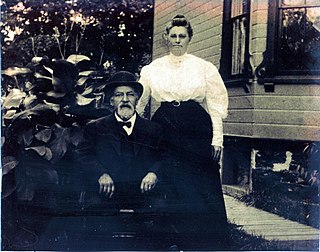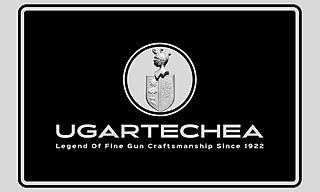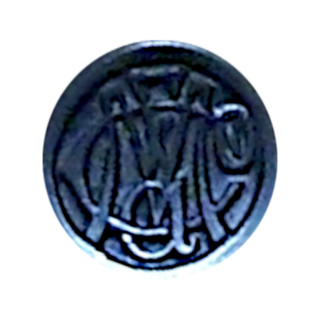
A revolver is a repeating handgun that has at least one barrel and uses a revolving cylinder containing multiple chambers for firing. Because most revolver models hold up to six cartridges, before needing to be reloaded, revolvers are commonly called six shooters.

In firearms terminology, an action is the functional mechanism of a breech-loading firearm that handles the ammunition cartridges, or the method by which that mechanism works. Actions are technically not present on muzzleloaders, as all those are single-shot firearms with a closed off breech with the powder and projectile manually loaded from the muzzle. Instead, the muzzleloader ignition mechanism is referred to as the lock.

John Moses Browning was an American firearm designer who developed many varieties of military and civilian firearms, cartridges, and gun mechanisms – many of which are still in use around the world. He made his first firearm at age 13 in his father's gun shop and was awarded the first of his 128 firearm patents on October 7, 1879, at the age of 24. He is regarded as one of the most successful firearms designers of the 19th and 20th centuries and a pioneer of modern repeating, semi-automatic, and automatic firearms.

E. Remington and Sons (1816–1896) was a manufacturer of firearms and typewriters. Founded in 1816 by Eliphalet Remington in Ilion, New York, on March 1, 1873, it became known for manufacturing the first commercial typewriter.
The Winchester Model 1897, also known as the Model 97, M97, Riot Gun, or Trench Gun, is a pump-action shotgun with an external hammer and tube magazine manufactured by the Winchester Repeating Arms Company. The Model 1897 was an evolution of the Winchester Model 1893 designed by John Browning. From 1897 until 1957, over one million of these shotguns were produced. The Model 1897 was offered in numerous barrel lengths and grades, chambered in 12 and 16 gauge, and as a solid frame or takedown. The 16-gauge guns had a standard barrel length of 28 in (71 cm), while 12-gauge guns were furnished with 30 in (76 cm) barrels. Special length barrels could be ordered in lengths as short as 20 in (51 cm) or as long as 36 in (91 cm). Since the time the Model 1897 was first manufactured, it has been used to great effect by American military personnel, law enforcement officers, and hunters.
Remington Arms Company, LLC was an American manufacturer of firearms and ammunition. It was formerly owned by the Remington Outdoor Company and broken into two companies, each bearing the Remington name. The firearms manufacturer is Remington Arms owned by RemArms LLC, and the ammunition business is Remington Ammunition owned by Vista Outdoor Inc.
Savage Arms is an American gunmaker based in Westfield, Massachusetts, with operations in Canada and China, PRC. Savage makes a variety of rimfire and centerfire rifles, as well as Stevens single-shot rifles and shotguns. The company is best known for the Model 99 lever-action rifle, no longer in production, and the .300 Savage. Savage was a subsidiary of Vista Outdoor until 2019 when it was spun off.
Pump action is a type of manual firearm action that is operated by moving a sliding handguard on the gun's forestock. When shooting, the sliding forend is pulled rearward to eject any expended cartridge and typically to cock the hammer or striker, and then pushed forward to load a new cartridge into the chamber. Most pump-action firearms use an integral tubular magazine, although some do use detachable box magazines. Pump-action firearms are typically associated with shotguns, although it has been used in rifles, grenade launchers, as well as other types of firearms. A firearm using this operating mechanism is colloquially referred to as a pumpgun
The Remington Model 870 is a pump-action shotgun manufactured by Remington Arms Company, LLC. It is widely used by the public for shooting sports, hunting and self-defense, as well as by law enforcement and military organizations worldwide.
Marlin Firearms Co. is an American manufacturer of semi-automatic, lever-action, and bolt-action rifles. In the past, the company, now based in Madison, North Carolina, and formerly based in North Haven, Connecticut, made shotguns, derringers, and revolvers. Marlin owned the firearm manufacturer H&R Firearms. In 2007, Remington Arms, part of the Remington Outdoor Company, acquired Marlin Firearms. Remington produced Marlin-brand firearms at its Kentucky and New York manufacturing facilities. In 2020, Sturm, Ruger & Co. bought the Marlin business from bankrupt Remington Outdoor Company.
The Ithaca 37, also known as the Ithaca Model 37, is a pump-action shotgun made in large numbers for the civilian, law enforcement and military markets. Based on a 1915 patent by firearms designer John Browning for a shotgun initially marketed as the Remington Model 17, it utilizes a novel combination ejection/loading port on the bottom of the gun which leaves the sides closed to the elements.

H&R 1871, LLC, or more commonly known as Harrington & Richardson, is an American brand of firearms and a subsidiary of JJE Capital Holdings. H&R ceased independent production February 27, 2015.

Daniel Myron Lefever was an American gun maker, popularly known as "Uncle Dan Lefever". He is best known as the inventor of the hammerless shotgun, first introduced in 1878. He was buried at Woodlawn Cemetery, Section 32, Plot 96

The Auto & Burglar Gun was a US-made factory-built handgun that was commercially manufactured by configuring a standard double-barrel shotgun with a pistol grip, at first engraving and later stamping "Auto & Burglar Gun" on each side of the frame, and shortening the barrels to about 10" to 12.2" in length. A holster with a flap and a snap was available for purchase from Ithaca. It was outsourced to a leather company and was embossed with "Auto & Burglar" on it. They are also very rare and are infrequently seen for sale in any condition.
The Browning Automatic 5, most often Auto-5 or simply A-5, is a recoil-operated semi-automatic shotgun designed by John Browning and manufactured by Fabrique Nationale de Herstal. It was the first successful semi-automatic shotgun design, and remained in production until 1998. The name of the shotgun designates that it is an autoloader with a capacity of five rounds, four in the magazine and one in the chamber. Remington Arms and Savage Arms sold variants called the Remington Model 11 and Savage Model 720 that were nearly identical but lacked the magazine cutoff found on the Browning.
Tobin Arms was a firearms company started in 1905 in Norwich, Connecticut, United States. It produced side-by-side and double-barrel shotguns in various grades. The company moved to Woodstock, Ontario, Canada in 1909 or 1910. It then made shotguns until 1925 before shutting down.
A coach gun is a modern term, coined by gun collectors, for a double-barreled shotgun, generally with barrels from 18 to 24 inches in length, placed side-by-side. These weapons were known as "cut-down shotguns" or "messenger's guns" from the use of such shotguns on stagecoaches by shotgun messengers in the American Wild West.

Armas Ugartechea is a Basque Spanish manufacturer of guns and rifles located in Eibar, is a privately held Spanish firearms manufacturing company. Its firearms are used worldwide for a variety of sporting and hunting purposes. It produces several models of double-barreled shotgun. It is devoted to the craft manufacturing of fine hunting shotguns and is the heir of a long craftsman tradition that has cleverly incorporated new technologies in the production of its guns, and, at the same time, keeping its traditional know how. It was the first Spanish company to start making under and over barrel guns. I. Ugartechea is well known for the quality of its work both at home and abroad. Is one of the few gunmakers to produce its own barrels, flawless at best. A present, Armas Ugartechea sells its guns worldwide. Among its customers are heads of state and monarchs from several countries, as well as top hunters and crack shots. The Ugartechea Family is still in charge of the company which is a basic principle, as they are the ones who know better how to optimize the manufacture of these firearms, which combine with craftsman work the best technology.

The Meriden Firearms Company of Meriden, Connecticut, USA manufactured small arms from 1905 to 1918. Meriden manufactured 20 varieties of hammer and hammerless revolvers with an output of 100 handguns a day in 1906. In addition to revolvers the company manufactured shotguns and rifles.

A multiple-barrel firearm is any type of firearm with more than one gun barrel, usually to increase the rate of fire or hit probability and to reduce barrel erosion or overheating.











